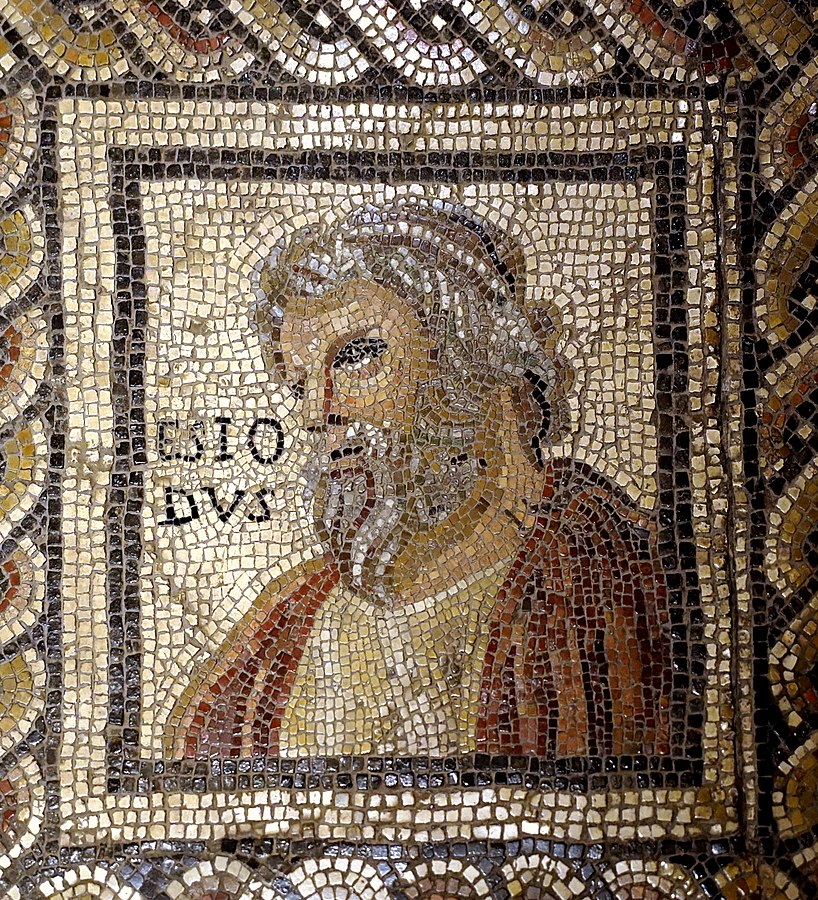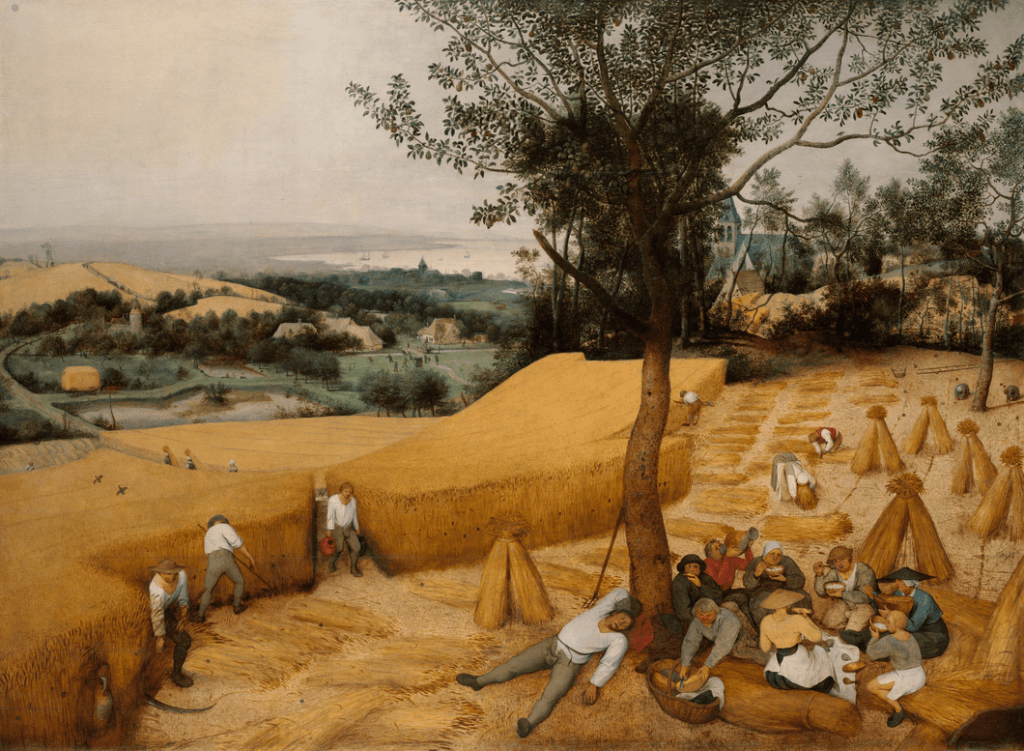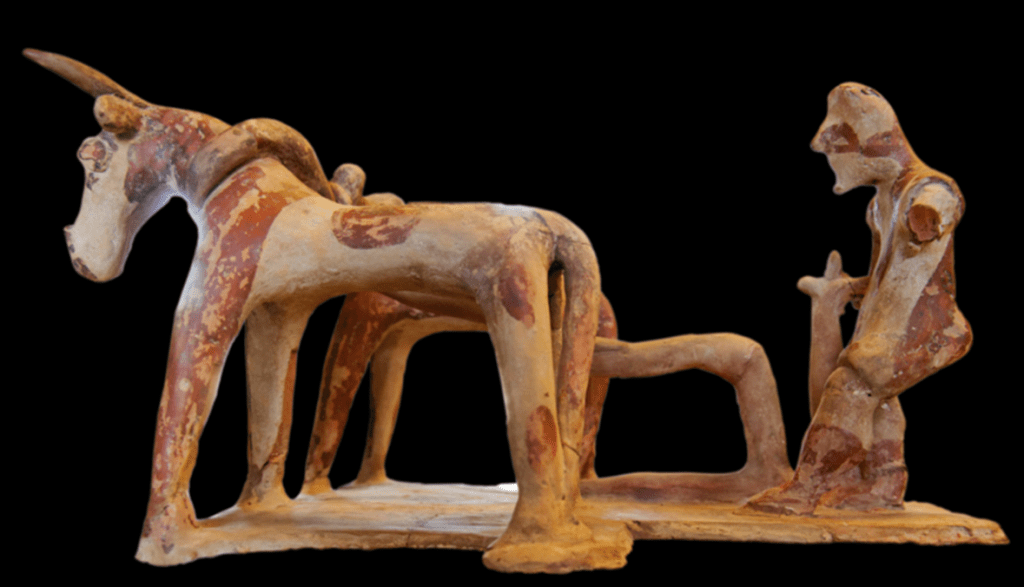Samuel Gartland and David Tandy
Let us begin on a farm at the start of the 7th century BC. Imagine the scene- you are a hardworking landowner, expert in estate management, struggling to make a decent existence out of the half a farm left to you by your immigrant father. Your feckless brother has wasted or lost most of his half of the inheritance to the big-men in the nearby town. You need to make the most out of your measly 30 acres in the sub-optimal soils of upland Boeotia in central Greece. You know all the tricks: keeping your slaves busy, where to find people who need work, when to hire them and when to fire them. Master of all you survey, you also know how to use animals to maximize the productivity of the land and to guard your property from those who would wish to steal it:
Urge your slaves to thresh out Demeter’s holy grain, whenever strong Orion first appears, in an airy place and on the well-rolled threshing floor. With a measuring scoop give heed to storing it well in vats. When you have put away all your sustenance under lock inside your oikos, I exhort you to put your worker out of the oikos and to search for a hired girl without a child; a hired girl with a child at her breast is hard. Tend also to your jagged-toothed dog– do not stint on his bread – lest a day-sleeping man seize your goods. Bring in fodder and litter that you may have an abundance for the oxen and the asses. But then have the slaves cool off their poor knees and set loose the oxen pair. (Hesiod Works and Days 597–608)

The slaves are busy working with the animals, and getting everything ready for the winter, while the household worker’s contract is ended, and a woman with no dependents is sought to work in the household. Our gaze is Hesiod’s: we are interested in his farm, and generally we are sympathetic to his aspirations of good management and prosperity.
But what if it followed the other figures in the landscape? Where do these enslaved people come from, what are the conditions of their existence, and are they lucky to have such a benevolent enslaver who allows them to rest their bodies when it suits him? Why are there so many young women (with and without children) available for hire and to become part of Hesiod’s household? Where does our worker who is replaced go when the boss fires him and kicks him out? Does his precarious existence and penury perhaps drive him to the night-shift work of burglary and sharp-toothed dog-evasion at the very estate he previously was gainfully employed in?

The Homeric world usually operates at a different scale. There are so many flocks and herds on Odysseus’ oikos (household estate) that it would require between 200 and 250 men to tend them. How does one feed so many mouths? Only by growing and tending enormous fields of grain, orchards of fruit trees, and vineyards. In a different context we see another version of Hesiod’s land manager, as he appears on the Shield of Achilles in the Iliad:
On it he [Hephaestus] placed a temenos (domain / enclosure) of a basileus (king), where workers were harvesting, holding sharp sickles in their hands. Some handfuls were falling along the furrow thick to the ground, while others the sheaf-binders were binding in bands. Three sheaf-binders stood at hand; behind them boys, gathering handfuls and bringing them in the crooks of their arms, unceasingly brought them to the binders. Among them in silence at the furrow stood a basileus, sceptre in hand, delighting in his heart. Heralds apart under an oak were busy preparing a meal, and they were busy with a great ox they had sacrificed, and women were sprinkling much white barley on a meal for the workers. On it he placed a vineyard weighed heavily down with clusters, a vineyard fine and of gold; the grapes in the air were black and he set them throughout on poles of silver. Around it he drove a trench and around that a fence made of tin; there was only a single path leading to the vineyard, on which traveled the vintagers, whenever they reaped the fruit of the vineyard. Maidens and youngsters were lightheartedly carrying honey-sweet fruit in their woven baskets. In their midst a boy was playing a pleasant song on the shrill lyre and singing a Linus song with his clear voice. And the workers striking the earth in unison did follow with song and shout, keeping time with their feet. (Homer Iliad 18.541–72)

The scene is at first bucolic: there is song, there is an excess of food, everyone has their role and is busy and fruitful in their work. All is well-ordered, crops are cut in straight lines, workers are filled with happiness to perform these tasks. But at the heart of the image is the Hesiodic figure, able to stand by in idle silence as this whole community of subordinates – young, old, specialized in different tasks – works busily to his profit.
These are our earliest narratives of the landscapes of Ancient Greece, and in them are subordinated people of all levels. As our literary record begins so does our awareness that the real, historical communities of Archaic Greece inherit an expectation of already unequally distributed resources, and powerful men determine the fate and quality of life for the great majority around them.

The tension and competition between elite peers such as Hesiod and the silent landowner of the Iliad, and the gift-gobbling men of the nearby town, the very men who separated Hesiod’s brother’s inheritance from him, produced tensions that needed to be resolved without routine violence and in an acceptably just manner. At the same time, the solidarity produced in the community of the working poor (that we see portrayed in such golden-tinged terms in the Iliad), allowed coordinated pressure from the subordinated masses to be put on these elite landowners so as to offer some protections against the worst injustices of the very uneven distribution of resources. The resulting political community was the city-state, the polis.
Within any polis, we can expect to see a wide variety of subordinate groups in urban and rural landscapes. If we look to Athens and Attica we see that the polis offered only a limited solution to these problems of mass exploitation of subordinates. And as we come in to the later Archaic and Classical periods it is possible to begin to quantify some of the inequalities, and much of it is surprising, if not shocking. If the members of the highest three (of four) production classes produced the minimum production amounts to enter their classes, these 15% of citizens had to control 85% of the arable land in Attica. This left 16,000 hectares for the use of 85% percent of the population, not nearly enough for the remaining 17,000 citizens to grow enough grains feed their families; this prevented them from avoiding penia, the need to provide labour to others in order to gain the necessary calories of a decent existence.

Pressure from below brought about change. In the 590s, the statesman Solon brought legislation through the Athenian Assembly that reduced this absurdly large group of 85 per cent impoverished people gradually to below 50 per cent by the time of Cleisthenes, archon for 508/7. Yet, as we often see, when the position of one group is improved, another suffers as a result. And, after Solon’s reforms, the relief brought to the working 85 per cent had to lead to a labour shortage, which was met by the importation of enslaved men and women from outside.
Enslaved women did domestic work in the homes of their owners. Enslaved men worked the fields of the wealthy, as we saw above: they tended the flocks and herds of their owners. Many slaves of citizens could find their days spent working on state construction projects; the master collected his own wage and his slave’s wage too.

Like everyone else, enslaved people could look to improve their own situation. Whether it be deserting their enslavers – more than ten thousand left the Athenian countryside during the Peloponnesian War (431–404 BC) or on an individual basis by triggering mechanisms where they could try and find a new master, such as we see at the Theseion at the edge of the Agora. Perhaps the greatest expression of this type of agency was after the sea battle of Arginusae in 406 BC, where large numbers of enslaved participants in the battle were given the status of Plataeans – which granted most of the privileges of Athenian citizenship.

This model of citizenship existed because the Plataeans, a whole citizen community, had already been block-granted a refugee citizen status in Athens. The Plataeans are themselves an example of the precariousness experienced at the level of whole communities. Repeatedly kicked out of their central Greek homeland by their neighbouring Thebans, they were forced to take refuge in Athens until they could be restored:- in two periods between the 420s and 330s BC, they spent more than 60 years as a community in exile. In Ancient Greece, cities were regularly and routinely destroyed by other cities, subjecting and exposing large populations to violences of all types.
In 373, the Thebans destroyed another Boeotian polis, Thespiae (the hometown of Hesiod’s big-men). Very unusually, we can see the experiences of an individual caught up in this. One of the most famous women in Classical Greece, Phryne, was young when her family fled and took refuge in Athens. Despite being a child, female, and living as a refugee (all aspects that multiplied her precariousness), she was able to use her beauty and her wits to build effective networks in Athens. Through these she become the most in-demand model in Greece, perhaps the basis for Praxiteles’ Aphrodite of Cnidus, and wealthy enough to dedicate a statue of herself among the kings and gods at Delphi.

Phryne’s visibility is unique: we cannot see so clearly the thousands of other Thespian (or Plataean) refugees. We must imagine that the majority lived a perilous and penniless existence, like the vast majority of people in Ancient Greece. There were other resident foreigners who had chosen to come to Athens for economic opportunities. We see them most often when they challenge the privileges of citizens to whom they were legally subordinate; or in the case of merchants from the eastern Mediterranean and Egypt, we see them petition the Athenian state itself, when as a group they ask for (and get) permission from the Assembly to build a space to worship their own gods. Agency, whether it be economic, social, or political, was a precious commodity, always hard won and ephemeral. As with so much else, we are only able to witness this agency when it infringes on those in power.
Those listening to the performances of Hesiod and Homer in the early 7th century saw their own world reflected, but those listening to the same poems at the end of the Classical period in Athens would still have recognized the figure of the subordinating landowner. Indeed, we see him in Xenophon’s landowner/estate manager Ischomachus in the Oeconomicus.
It is possible to make people more obedient just by speaking to them, explaining that it is advantageous for them to be obedient, but with slaves the technique used with wild animals is very effective at teaching obedience. For if you satisfy their appetites with what they enjoy, you will accomplish plenty back out of them; ambitious natures are sharpened by praise. Some natures hunger for praise no less than others hunger for food and drink. (Xenophon Oeconomicus 13.9)

Like Hesiod more than three centuries before, Xenophon sees animals and human labour together in the landscape, and their motivations and treatment can be similar. Hesiod himself (Works and Days 471) insisted that the best thing for mortals is εὐθημοσύνη (euthēmosunē, “good management”), by which he meant everything in its proper place at the proper time. This term does not surface again until Xenophon, who embraces the notion of good management in his Cyropaedia (8.5).
Our informal research project, based at the University of Leeds, has been focussed on Subordinates for about ten years. There is a module on Subordinates (in Greece and Rome) that the Classics program offers every year. Now, about fifteen senior staff (from eleven universities in seven countries on three continents) have organised a number of symposia, at Leeds and Oxford, and published a collection of essays that attempt to find commonalities among subordinated groups. Our work continues, as we identify these commonalities through a diversity of perspectives on, and approaches to, the ancient world. We want to recognise the common experiences of precarity, what led people to be in positions of vulnerability to others, and what effects this had on their lives.

In this world of subordinate studies, things are moving fast. We have seen over the past few years how much sensitivities toward subordinated peoples have increased and the way in which language is used has changed. Enslaver and enslaved are becoming accepted as orthodox terms. Routine sexual violence against those with little power to resist it is no longer a matter of titillation or shrugging, but of empathy, outrage, and the recognition of the universality of violent trauma. Previously, behaviours we now find abhorrent would be explained as normal within their cultural context, but we now work to ask fundamental questions of the drivers of that culture.
It is easy to pass over the experiences of subordinated people of all types. We can’t see them, we don’t have a name we can call them, and we get no more than glimpses of how numerous these groups are. They were subordinated in their own time, and rendered voiceless and invisible by our literary sources and, until recently, by most historians of Ancient Greece. To see them we need to work across specialisms, with ingenuity, and with sensitivity to the experiences we seek to witness. Working together we can ask better questions and uncover experiences of the subordinated and enslaved, who at all times formed the great majority of the populations of Ancient Greece.

Samuel Gartland is Associate Professor of Ancient Greek History and Culture at the University of Leeds.

David Tandy is Professor of Classics Emeritus and Distinguished Professor of Humanities Emeritus at the University of Tennessee, and Visiting Research Fellow in Classics at the University of Leeds.
Further Reading
C. Courrier & J.C. Magalhães de Oliveira (edd.), Ancient History from Below: Subaltern Experiences and Actions in Context (Routledge, London, 2021).
A. Duplouy & R. Brock (edd.), Defining Citizenship in Archaic Greece (Oxford UP, 2018).
A.T. Edwards, Hesiod’s Ascra (Univ. of California Press, Berkeley, CA, 2004).
S. Forsdyke, Slaves and Slavery in Ancient Greece (Cambridge UP, 2021).
S.D. Gartland & D.W. Tandy (edd.), Voiceless, Invisible, and Countless in Ancient Greece: The Experience of Subordinates, 700–300 BCE (Oxford UP, 2024).